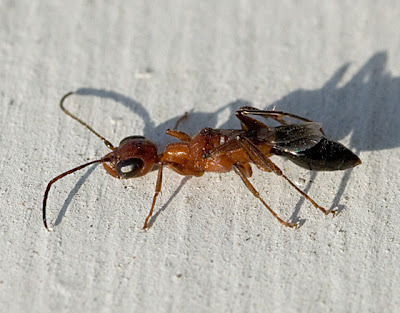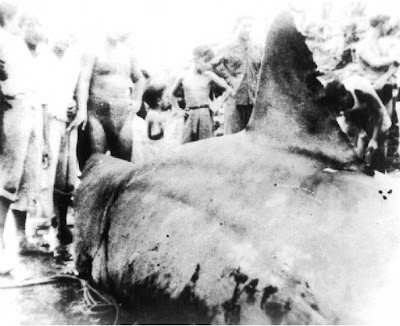Gordon Grice's Blog, page 53
June 14, 2012
Animal Attack Movies: Alien
 A larval alien emerges from its human host
A larval alien emerges from its human hostThe animal in question is a merely science fictional one, but it’s clear somebody involved really enjoyed earthly wildlife—particularly the parasitoid insects. I wrote about the life stages of certain parasitoid wasps in The Red Hourglass and again in this essay on the things I found in an elm tree:
Secrets of the Siberian Elm Part 1
Secrets of the Siberian Elm Part 2.
Here's the species of parasitoid wasp from my elm:

In the movie, the Alien goes through an insect-style metamorphosis. From a sort of seed pod or oothecum emerges a larva that attaches itself to a man’s face. It inserts a tube into his gut through his mouth to feed itself. The next larval stage emerges explosively from the man’s abdomen. Because we see the events only from the point of view of the clueless humans, it’s not clear exactly what mechanism the alien used here; possibly it emerged from the exoskeleton of its earlier larva and crawled into the man’s stomach, or perhaps the two larval stages are actually separate individuals, one the parent of the next. That second possibility isn’t too far-fetched. Some earthly Cnidarians progress through a similar cycle, with different individuals taking on different stages. (Cnidarians include jellyfish, sea anemones, and the like, but not all of them have that kind of life cycle.)
The final, adult stage of the alien seems to nourish itself by predation before laying its eggs. I suggest it may have raided from the ship’s stores as well. It pretty much had to, actually, because only five humans fall victim to it, and it doesn’t even eat them all; it uses at least some of them as fodder for its parasitic young. (Here's a deleted scene of Sigourney Weaver discovering the larder stocked with humans.)
Besides the real-life habits of insects, it seems to me that Alien draws on two interesting sources. One is a 1958 movie atrociously titled It: The Terror from Beyond Space. Same feel: a sweaty, claustrophobic spaceship. Same premise: a small crew picked off by a dangerous alien. This one is a sort of reptilian vampire. An animal with an alien biochemistry is extremely unlikely to find earthly blood digestible, of course, but the writers of It apparently didn’t know that. Neither did H. G. Wells, actually; he used the same gimmick in The War of the Worlds.
The other possible inspiration is the Doctor Who story The Ark in Space, written by Robert Holmes. Holmes’s Wirrn appear in several metamorphic stages, are parasitic on humans, and, in adult form, look a lot like wasps.
 The Doctor and Sarah Jane examine a dead WirrnThere's a whole universe of Alien stories, by the way--sequel films, comics, novels, and so on. Some of these expand on the biology of the Xenomorph, as they call the Alien. I'm sticking with the first movie in this post because that's the one I like best.
The Doctor and Sarah Jane examine a dead WirrnThere's a whole universe of Alien stories, by the way--sequel films, comics, novels, and so on. Some of these expand on the biology of the Xenomorph, as they call the Alien. I'm sticking with the first movie in this post because that's the one I like best.
Published on June 14, 2012 03:00
June 13, 2012
Hippopotamus Kills One, Injures Another

Hippo kills man in night attack:
"A hippopotamus has killed a man at Kilimambogo village in Thika East, Kiambu county, and seriously injured another . Peter Kariuki Kamau’s body was found yesterday morning after the animal killed him on his way home from Makutano shopping centre. His brother Benson Kamau said Kamau, 35, was walking home from the market at 7pm on Wednesday when the hippo attacked him near Kilimabogo Teachers Training College. Pastor John Gathuru Kimani, 57, fought with the beast for almost one hour but suffered two broken ribs and injuries on the back and face. "
Published on June 13, 2012 02:30
June 12, 2012
Landing the Biggest Sharks
 In Shark Attacks: Inside the Mind of the Ocean's Most Terrifying Predator
In Shark Attacks: Inside the Mind of the Ocean's Most Terrifying Predator , I mention the case of a man swallowed whole by a great white shark. That shark was estimated at better than 20 feet long. The great whites below may be in that range. As this page explains, the record size for a great white is much contested.
, I mention the case of a man swallowed whole by a great white shark. That shark was estimated at better than 20 feet long. The great whites below may be in that range. As this page explains, the record size for a great white is much contested. The specimen above isn't a great white, but a tiger shark. Tiger sharks are more slender than great whites, so they don't reach the multi-ton weights suspected for some great whites. Nonetheless, they have managed to eat a number of people--in pieces.


Special thanks to Dee Puett.
Published on June 12, 2012 02:30
June 11, 2012
Further Thoughts on Cannibal Attacks

More discussion following the recent posts about the Miami cannibal attack. Thanks to James Smith for his thoughtful contributions.
James Smith: Speculation being what it is, it's hard to say--but there's certainly precedent (think the Vikings, to name just one group) for somebody consuming some mind-altering drug or combination thereof and believing themselves to be a wolf, bear or other dangerous animal admired for its fighting prowess...the difference is, ancient people did this as a function of their society, not acting out on their own.
Gordon Grice: Hard to know how much of history is true, but there are precedents in chronicles and myth for "anti-social" predation on fellow humans. Sawney Beane and his clan come to mind.
James Smith: While Sawney Beane's story is a little confused as to exact time (probably due to confusion between James I of Scotland or James VI of Scotland/I of England) and probably prone to some exaggeration, there is no real reason to doubt its essential points. I actually had a pet kingsnake named Sawney when I was a teenager (the reason for the name is, I'm sure, obvious.) The Beanes, though, didn't seem to be motivated (from what we can gather) by psychosis or drugs...Sawney and his wife simply fell back on eating people during lean times and taught their children and grandchildren that this was normal. It has sometimes occurred to me that the legends of werewolves and child-eating witches probably represent earlier societies' attempts to rationalize and explain the deviant behavior of anti-social predators, a la Albert Fish, for instance.
Gordon Grice: That's an interesting idea, James. Probably the best evidence for it is scarcity of serial killer stories in history prior to the Victorian era. I've heard that fact used as a basis for arguing that serial murder is a modern phenomenon, but it seems more likely to me that myths of ogres and the like are earlier ways of understanding aberrant murder and cannibalism. I'm skeptical of the specifics about the Beanes, as the whole story seems to reek of ogre-mythology. But the premise that people could establish a cannibal custom within a society that abhors it has precedent in well-attested cases like that of Fritz Haarman. (It also has precedent among chimpanzees, by the way.)
Werewolves as real-life cannibals also makes sense to me. Our friend Guy Endore implies just such a connection in his novel The Werewolf of Paris, which plays lycanthropic variations on the case of Sgt. Bertrand. In fact, even in Roman times it seems as if lycanthropy was an explanation, or maybe just a metaphor, for drunkenness and rape. (There's the drug connection again.)
I'm skeptical regarding the witchcraft part. When William Arens reviewed the literature on cannibalism, he found it was often attributed to a culture by its enemies, but in most cases, other evidence was lacking. I think that's what's at work in reports of witchcraft practices. In the Renaissance, accusations of witchcraft were frequently leveled against heretical sects. Baby-eating was part of that slander; it was a way the Church had of demonizing its enemies. The same accusations were made against Jews. So I suspect those particular allegations were politically motivated, not based on any reality. I also suspect that sort of motive behind the accusations against, for example, Gilles de Rais, who supposedly murdered hundreds of children for giggles.
Published on June 11, 2012 03:00
June 10, 2012
Giant Bull Shark Surprises Researchers

Photo: Giant Bull Shark Surprises Researchers - Yahoo! News:
""It's one of the biggest bull sharks I've ever caught, and it's the biggest bull shark I've ever tagged," Hammerschlag said — and he's tagged more than 1,000 sharks. "When this guy rocked up, it just took my breath away."
It turned out it was, in fact, a lady. Like many other shark species, female bull sharks are larger than males. But bull sharks of either sex are nothing to be trifled with. Like great white sharks and tiger sharks, bull sharks have serrated teeth — an accessory that allows them to rip and tear apart their meals, which means they can go after far bigger prey than smaller shark species can.
Bull sharks "have the most testosterone of any animal on the planet."
Thanks to Dee Puett for the news tip.
Published on June 10, 2012 03:00
June 9, 2012
People Just Bite

In the midst of sensationalist reports from all quarters, this article points out that humans biting each other, and even biting off each other's body parts, is rather common. It's not new and it need not involve drugs. Obviously the case of Rudy Eugene in Miami is gorier than most; and it's disturbing that Eugene seemingly attacked with no provocation and no concern for his own safety. It would be nice if we could dismiss such behavior as absolutely outside human norms, as zombie-like. . . but it wouldn't be true.
* In March, one man bit off part of another man's ear in Springfield, Mass., after a youth basketball game. The Republican report did not indicate any drugs were involved.
* A fight over what was on television resulted in one man biting off another's ear at a diner in Staten Island last week, Staten Island Advance reported. There was no indication drugs were involved.
* According to WISH, an Indiana man's ear was bitten off in a 2009 road rage incident. Drug use was not to blame.
* An LA Times article describes a highly publicized finger-tip biting incident in 2009, resulting from anger over healthcare reform, not drugs.
* Internet reports reveal more than a few fights recent and dated- some involving alcohol, some not- in which participants' tongues and testicles were bitten off.
Published on June 09, 2012 03:00
June 8, 2012
Rhesus Monkeys of Delhi
 Minghong/Creative Commons
Minghong/Creative CommonsAnother case of habituation.
Fed by Indians, Monkeys Overwhelm Delhi - NYTimes.com:
"The first interloper stepped in front of her on the sidewalk and silently held up his hand. The second appeared behind her and beckoned for her bag. Maeve O’Connor was trapped. Resistance would have been dangerous, so Ms. O’Connor handed it over. The two then sauntered arrogantly away. The whole encounter lasted no more than 15 seconds — just one more coordinated mugging by rhesus monkeys. . . some residents are getting a bigger monkey, a langur, to urinate around their homes."
Published on June 08, 2012 03:00
June 7, 2012
Miami Cannibal Attack in Perspective

In the May 26, 2012, Miami cannibal attack, assailant Rudy Eugene was fatally shot as he assaulted Ronald Poppo on the MacArthur Causeway in Miami, Florida. During the 18-minute filmed encounter, Eugene (who himself had stripped nude) beat Poppo unconscious, removed his pants, and chewed off most of his face above the beard, including his left eye. As a result of the incident's shocking nature and subsequent worldwide media coverage, Eugene came to be dubbed the "Miami Zombie" as well as the "Causeway Cannibal". --Wikipedia
*
One day in 2009, Travis the chimpanzee was out of sorts. His human companion, Sandra Herold, had been trying to calm him down all morning, even serving him tea laced with the anti-anxiety drug Xanax. She called her friend, 55-year-old Charla Nash, for help. Travis knew Nash well; they had always gotten along. When she stepped out of her car, he leapt on her and gnawed her face off. She tried to protect herself with her hands: he chewed her fingers off as well. Herold bludgeoned Travis with a shovel, but she couldn’t stop him. She tried a butcher knife next. At some point she took refuge in her vehicle and phoned the police, telling them that Travis had ripped her friend apart and was eating her. . . . Nash lost her fingers, lips, nose, palate, and eyelids in the attack; afterwards, doctors removed her ruined eyes.--The Book of Deadly Animals
*
[The sloth bear] invariably attacked the face of the victim, which he commenced to tear apart with his tremendously long and powerful claws, in addition to biting. . . . Quite half the injured had lost one or both eyes; some had lost their noses, while others had had their cheeks bitten through. Those who had been killed had died with their faces almost torn from their heads. [One victim was found] lying at the foot of a tree in a puddle of his own blood. His face was a mass of raw flesh and broken bones, and the only way of distinguishing that he was breathing was by the bubbles of air that forced their way through his clotting blood.--Kenneth Anderson, Man-Eaters and Jungle Killers
*
[A] young man was found disemboweled and literally defaced. One of the searchers who found the body assumed he was looking at a murder scene—until he spotted a cougar five yards from the body.--The Book of Deadly Animals
*
In late 2005, Isabelle Dinoire. . . underwent a 15-hour operation in Amiens, in the north of the country, after her original face was ripped to pieces by her pet dog.-The Telegraph
*
Fifty percent of dog bites to children are on the face.--The Book of Deadly Animals
*
In 1995, a woman climbed into the lion exhibit at the National Zoo in Washington DC. Her body could not immediately be identified because the lions left her neither face nor fingerprints.--The Book of Deadly Animals
*
Simborg then heard the hyena biting her face. It is the sound, specifically, that she remembers, followed by the feel: “My whole face just came open.”--The Book of Deadly Animals
*
A Chinese man whose face was badly disfigured after an attack by a black bear received a partial face transplant. . . Li Guoxing was given a new cheek, upper lip, nose, and an eyebrow. . . Li had been badly mauled in an encounter with a black bear in the southern province of Yunnan. --China Daily
*
One of the hyenas seized an eleven-year-old boy by the face and dragged him, severing his nose, destroying one eye and dislocating the other, crushing the orbital bones, and removing most of the left side of his face.--The Book of Deadly Animals
*
The African’s face ended below his cheekbones: his nose, palate, upper teeth, tongue, and almost his entire lower jaw were gone. Only his eyes and the upper part of his head remained intact and yet he was alive and moderately healthy and had taught himself to swallow food. He had received one bite, just one snap.--James Clarke, Man Is the Prey
*
In 2000, a pair of pet ferrets inflicted more than 100 wounds on the face of a 10-day old girl while her mother slept.--The Book of Deadly Animals
*
Two teenaged male chimps escaped from a nearby cage. . . . One of them bit off Mrs. Davis’s thumb. Her husband tried to protect her. The two teens then concentrated their attack on him. He lost a foot, all of his fingers, his testicles, part of his buttocks, an eye, and parts of his nose, cheek, and lips.--The Book of Deadly Animals
*
A woman was working in a potato field with her three-month-old son. A chimp appeared, pursued her when she fled, tripped her, and wrested the baby from her. A man with a spear managed to drive the chimp away, but it already eaten the baby's upper lip and nose.--The Book of Deadly Animals
Published on June 07, 2012 02:30
June 6, 2012
Blue Shark Feeds on Giant Squid
Giant squid are hard to find, but a freshly dead specimen has turned up. The blue shark is scavenging the carcass.
Anglers' extraordinary find is no sea monster, but a giant squid:
"The crew obtained underwater footage of the squid being preyed upon by a blue shark, which is posted below.
McGlashan, who writes a weekly column for the Daily Telegraph, was quoted in the newspaper as saying the squid "must have died not that long before we found it because it didn't smell at all and its colors were still strong. Most giant squid remains are smelly and rotten and just off-white by the time someone finds them." "
Published on June 06, 2012 02:30
June 5, 2012
New eBook: Shark Attacks

Today we launch Shark Attacks: Inside the Mind of the Ocean's Most Terrifying Predator
 . It's a story of survivors. . . and those who didn't survive. You'll meet a ballroom dancer whose life began anew after she survived an attack. You'll hear the tales of fisherman and divers who lost their heads--and their feet. You'll meet a biologist who promises us hope. . . if only we can believe in fear.
. It's a story of survivors. . . and those who didn't survive. You'll meet a ballroom dancer whose life began anew after she survived an attack. You'll hear the tales of fisherman and divers who lost their heads--and their feet. You'll meet a biologist who promises us hope. . . if only we can believe in fear. This is the most explicitly environmental writing I've ever done. If you've read the shark chapter in The Book of Deadly Animals, you've only just begun to hear what I have to say about mayhem and miracles in the water.
Shark Attacks is an e-Book Short from National Geographic Books.
Published on June 05, 2012 02:00



